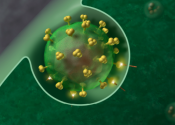Study suggests a way to stop HIV in its tracks
When HIV-1 infects an immune cell, the virus travels to the nucleus so quickly there's not enough time to set off the cell's alarm system.
Dec 1, 2017
0
322
When HIV-1 infects an immune cell, the virus travels to the nucleus so quickly there's not enough time to set off the cell's alarm system.
Dec 1, 2017
0
322

(Medical Xpress)—A diverse team of biologists has shown using induced pluripotent stem cells (iPSCs) that a gene mutation that causes malformations in the structure of the nuclear envelope of neural cells, is associated ...

(Medical Xpress) -- New research from scientists at the University of Cambridge provides critical insight into the formation of autophagosomes, which are responsible for cleaning up cellular waste.
Jul 26, 2011
0
0

Traditionally, RNA was mostly known as the messenger molecule that carries protein-making instructions from a cell's nucleus to the cytoplasm. But scientists now estimate that approximately 97 percent of human RNA doesn't ...
May 10, 2011
0
0
Scientists at the Francis Crick Institute and UCL have studied how proteins accumulate in the wrong parts of brain cells in motor neuron disease, and have demonstrated how it might be possible, in some cases, to reverse this.
Aug 6, 2021
0
848

A team led by LMU's Veit Hornung has elucidated the mechanism by which human cells induce inflammation upon detection of cytoplasmic DNA. Notably, the signal network involved differs from that used in the same context in ...
Oct 17, 2017
0
67

Neuroscientists at Georgetown University Medical Center say they have new evidence that challenges scientific dogma involving two fatal neurodegenerative diseases—amyotrophic lateral sclerosis (ALS), and frontotemporal ...
Dec 20, 2012
0
0
All animals face the challenge of deciding which chemicals in the environment are useful and which are harmful. A new study greatly improves our understanding of how animals sense an important class of potentially harmful ...
May 16, 2011
0
0

Researchers have identified a new mechanism that the tumor suppressor protein p53 uses to trigger cell death via apoptosis and have shown how the process could be harnessed to kill cancer cells. St. Jude Children's Research ...
Jul 30, 2015
0
32

Two proteins previously found to contribute to ALS, also known as Lou Gehrig's disease, have divergent roles. But a new study, led by researchers at the Department of Cellular and Molecular Medicine at the University of California, ...
Sep 30, 2012
0
0
The cytoplasm is the part of a cell that is enclosed within the plasma membrane. In eukaryotic cells, the cytoplasm contains organelles, such as mitochondria, which are filled with liquid that is kept separate from the rest of the cytoplasm by biological membranes. The contents of the cell nucleus are not part of the cytoplasm and are instead called the nucleoplasm. The cytoplasm is the site where most cellular activities occur, such as many metabolic pathways like glycolysis, and processes such as cell division. The inner, granular mass is called the endoplasm and the outer, clear and glassy layer is called the cell cortex or the ectoplasm.
The part of the cytoplasm that is not held within organelles is called the cytosol. The cytosol is a complex mixture of cytoskeleton filaments, dissolved molecules, and water that fills much of the volume of a cell. The cytosol is a gel, with a network of fibers dispersed through water. Due to this network of pores and high concentrations of dissolved macromolecules, such as proteins, an effect called macromolecular crowding occurs and the cytosol does not act as an ideal solution. This crowding effect alters how the components of the cytosol interact with each other.
This text uses material from Wikipedia, licensed under CC BY-SA